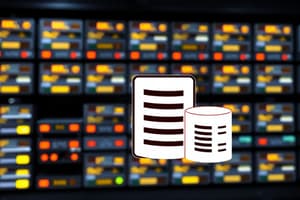Podcast
Questions and Answers
What is a flat-file database and how does it differ from a relational database?
What is a flat-file database and how does it differ from a relational database?
A flat-file database is a simple database that stores data in a single table, whereas a relational database consists of multiple tables that are related to each other.
How is data stored in a flat-file database and what are the limitations of this type of database?
How is data stored in a flat-file database and what are the limitations of this type of database?
Data in a flat-file database is stored in a straightforward format, typically as rows of records. Limitations include difficulty in handling large data sets and lack of relationships between data entries.
What are the advantages and disadvantages of using a flat-file database?
What are the advantages and disadvantages of using a flat-file database?
Advantages of flat-file databases include simplicity and ease of use, while disadvantages entail limited data structure and poor performance with large data sets.
How is data retrieved from a flat-file database and how is it used in applications?
How is data retrieved from a flat-file database and how is it used in applications?
Can a flat-file database be used for complex data analysis, and if so, how is this achieved?
Can a flat-file database be used for complex data analysis, and if so, how is this achieved?
What are the three basic terms that all databases contain?
What are the three basic terms that all databases contain?
What is the purpose of a 'Field' in a database?
What is the purpose of a 'Field' in a database?
How is a 'Flat-file Database' characterized?
How is a 'Flat-file Database' characterized?
What does the term 'Data Integrity' refer to?
What does the term 'Data Integrity' refer to?
Why is it important to define data types and formats before setting up a database?
Why is it important to define data types and formats before setting up a database?
What could happen if the date data format is not defined when creating a database?
What could happen if the date data format is not defined when creating a database?
Give an example of a data type and its format.
Give an example of a data type and its format.
What is an 'Entity' in the context of a database?
What is an 'Entity' in the context of a database?
Flashcards
Short Text
Short Text
A data type for strings under 256 characters used in databases.
Boolean
Boolean
A data type that limits entries to two options, like YES or NO.
Date/Time
Date/Time
Data type that combines date and time, with various formats available.
Currency Data Type
Currency Data Type
Signup and view all the flashcards
Flat-file Database
Flat-file Database
Signup and view all the flashcards
Table
Table
Signup and view all the flashcards
Record
Record
Signup and view all the flashcards
Field
Field
Signup and view all the flashcards
Entity
Entity
Signup and view all the flashcards
Attribute
Attribute
Signup and view all the flashcards
Data Types
Data Types
Signup and view all the flashcards
Data Integrity
Data Integrity
Signup and view all the flashcards
Study Notes
Flat-File Databases
- A flat-file database stores all records in a single table.
- It has no relationships between tables.
- Suitable for simple, single-user databases.
Database Terminology
- Table: Holds records and fields, defining database structure.
- Record: All data about a single item (e.g., Mercedes team details).
- Field: Each type of data held (e.g., TeamName, Points).
- Entity: Unique classification of data (e.g., team, person).
- Attribute: Single data item within a record (e.g., 'Mercedes' points).
Data Types
-
Data Type: Defines the kind of data (text, numbers, dates, etc.).
-
Text: Short text (under 256 characters) or long text.
- Numbers like phone numbers often use text format.
-
Numbers: Integers, decimals, scientific notation.
-
Boolean: Two options (e.g., TRUE/FALSE, YES/NO).
-
Date/Time: Combined date and time, with specific formats.
-
Currency: Specific currency symbol and decimal places.
-
Object: Non-keyboard input data (images, links).
-
Data integrity is ensured by specifying data types and formats upon database setup. This prevents inconsistent data entry.
Flat-File Database Comparison
- Flat-file databases are simpler than relational databases, which use multiple tables linked together.
- Data storage is in a single table in a flat-file database.
Flat-File Database Limitations
- Only suitable if there are no relationships between the data
- Not ideal for complex data analysis or large databases.
Studying That Suits You
Use AI to generate personalized quizzes and flashcards to suit your learning preferences.




